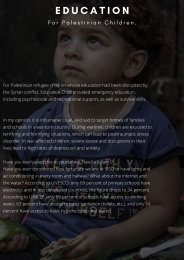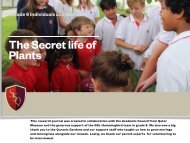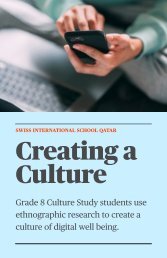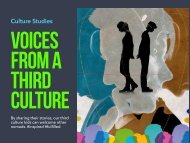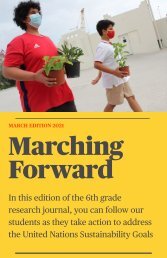without them, we starve
Welcome to the January edition of the SISQ 6th graders research and service learning journal where we celebrate curiosity and caring.
Welcome to the January edition of the SISQ 6th graders research and service learning journal where we celebrate curiosity and caring.
Create successful ePaper yourself
Turn your PDF publications into a flip-book with our unique Google optimized e-Paper software.
THE JANUARY 2021 EDITION OF ISQH
INVESTIGATION JOURNAL
Without
them, we
starve.
Global problems are a reality but
individuals can make a difference.
The 6th graders of SISQ make their voices heard.
WITHOUT THEM, WE STARVE. .................................. 3
WELCOME TO BOURGES.
FRIENDS OR FOES?
........................................ 5
................................................... 7
CAN BEES SURVIVE THE HEAT OF QATAR?
(ABRAR 6C) ............................................................... 14
IS IT GETTING TOO HOT FOR OUR BEES? (JANA
6C) .............................................................................. 19
CARPENTER BEES - IN DOHA? (BRIEUC 6C) ........ 23
WHY DO FARMERS USE ARTIFICIAL/CHEMICAL
FERTILIZERS INSTEAD OF ORGANIC FERTILIZERS?
(NATALIE 6C) ............................................................ 27
ARE PESTICIDES GOOD OR BAD? (CYRINE 6B) .. 35
THE HIGH PRICE OF UGLY PRODUCE (ZAHIRA 6B)
41
QATAR, IT IS 100% HALAL.... OR IS IT? (OLIVER 6A)
45
ABOUT OUR EXPERTS ............................................. 51
Without them, we starve.
Global problems are real but
individuals have the choice and
power to make a difference.
The 6th graders of SISQ make their voices
heard
IB LEARNERS AT SISQ ARE CARING.
THEY USE DATA TO IDENTIFY PROBLEMS
AND CRITICAL THINKING SKILLS TO
DEVELOP CREATIVE SOLUTIONS. THESE
ARE CALLED ATTITUDES TO LEARNING.
EVERY MONTH, WE WILL SHARE SOME OF
OUR DISCOVERIES.
© SISQ Individuals and Societies
Do you enjoy chocolate? How about strawberries?
Perhaps you enjoy a good cheeseburger? But maybe
you don’t enjoy those irritating bees that come into
your house. And bats just give you the creeps. And
pesky birds irritate you when they eat the fruit in your
garden.
But without those scary, irritating creatures, we
would lose 75% of our food supply and bees alone
produce food worth over $500 billion. Einstein
himself noted that if the bees die, humans will soon
follow.
Unfortunately, due to human greed, bees (and other
pollinators) are under threat.
Join our 6th graders on their adventure to save the
planet and create awareness about how humans and
pollinators can live together in harmony.
Welcome to Bourges.
Avaricum. Place of water. This is the name that
the ancient Romans gave to Bourges when
Julius Caesar invaded this region of France.
As you can see, it is still possible to visit the ancient
Roman ramparts and our students will go on an
exciting virtual visit to the same marshes that Julius
Caesar crossed.
Unlike Caesar, we are not greedy conquerors but
global citizens with an urgent mission to highlight
how people like you and me can make an important
difference to saving the planet.
You see, Bourges is also a natural heritage site
where ordinary people are making a huge difference
to ensure that humans live in harmony with animals.
Our students are about to discover how traditional
farming methods, geographical skills and biology
might just protect the world from starvation.
Please join us on our adventure to save the planet by
reading our very own publication where the 6th
graders will highlight how WE can make a difference.
WE ARE INCREDIBLY PROUD OF OUR STUDENTS FOR THE
COLLABORATION THAT THEY HAVE SHOWN. THE FRENCH
STUDENTS ARE TRANSLATING AND STUDENTS ARE
SUPPORTING ONE ANOTHER AS EDITORS. DESPITE COVID,
OUR STUDENTS CONTINUE TO CARE AND INSPIRE OTHERS
TO MAKE A DIFFERENCE.
Friends or Foes?
This article investigates whether bats and humans can
live together in harmony - Claire Olivier
Imagine a boxing match. In the red corner, we have a
creepy bat. “Don’t bats spread Covid?”, I hear you say. And
don’t they drink blood and turn into vampires? Surely, it’s a
well known fact that they fly into
your hair at night just to
terrorize you...
Or do they?
In order to investigate
whether bats and humans can
live in harmony, Mrs Olivier
decided to visit the Natural
History Museum of Bourges
where she met bat expert
Amelie Chrétien.
First of all, Amelie
reminds us that bats
are mammals too and
very similar to
humans. Just look at
our skeletons.
That’s right - we
have the same rib
cage, pelvis, arms and very similar jaws and skulls.
Bats give birth to life babies that they breastfeed.
When Amelie rescues baby bats, she has to feed them
kitten milk from a paintbrush - just like a mommy bat!
There is also no evidence that bats do cause Covid and, in fact,
they actually eat mosquitos and prevent malaria and other
diseases. Did you know that one bat can eat 600
mosquitos?
So what about our side of the boxing ring? According to
the Museum of Bourges, we are definitely far scarier than
bats. Bats drown in our swimming pools and get stuck in
our fences. They die on our road and in our windscreen
wipers. We poison them, throw stones at them, chase them
from our houses (which are their homes too) and pollute
the skies with electric lights so they can’t hunt.
This looks hopeless but Amelie has good news for us.
Saving the Climate and Saving the Bats
Bats are a lot like 6th graders - very curious little creatures.
To a bat, a wind farm is like a giant forest of trees. Until they
get sliced to death by the blades.
Wind energy is becoming a very popular fuel source in
France and the rest of Europe where it is designed to save
the environment by reducing air pollution but many bats
and birds pay a heavy price when they get sliced by the
blades.
The university staff made an agreement with the France
Énergie Éolienne (the owners of the wind farms) to develop
a creative way to save the bats and keep the farms
productive.
The museum staff mapped where they found the dead bats
and when they found them so that they could let the wind
farms know when the bats would be flying.
The blades turn at a speed of up to 280 km/hr and during
the period when the bats fly into France (migration period),
the museum has arranged for the wind farms to slow down
the blades.
This results in only a 3% loss of production but saves 90%
of the bats flying through the farms.
Paths of Darkness
Bats like rhinolophes, barbastelles and grands murins cannot
live in areas that are lit by artificial lights. The museum has
negotiated with the cities to change the lighting in the areas
where the bats have babies.
The big red blog is Paris
and you can see how
much light pollution is being produced . Bourges is the much
smaller red dot on the bottom right hand corner because the
museum persuaded the city to use safer lights and actually
switch off their lights during breeding seasons so the bats
could find husbands and wives and have bat families.
Mommy, I’m hungry
Amelie took us into the bat sanctuary where they rescue
baby bats and injured animals.
Firstly, they help residents to make bat homes (“nichoirs”) in
their own buildings. Guess what? One of the bat nests was on
the roof of my home!
Secondly, people can bring in bats if they find them injured
in their windshield wipers, swimming pools or fences. They
then get delicious kitten milk meals
When the bats get older, they then get fed some worms.
Look right. Look Left...and cross!
Unfortunately, bats also get squashed in traffic so the
university staff came to the rescue, once again.
At night, bats were going to hunt in the countryside and
had to cross a busy highway so the university staff tracked
the bats and built them a bridge so they could cross safely.
So, are bats and humans friends or foes? Can they live
happily together?
This little
rescue bat and
mommy Amelie
seem to think we
can!
A big thank you to
the staff of the
museum of Natural
History (Bourges).
Can Bees Survive the Heat of Qatar?
(Abrar 6C)
They are one of the most beautiful creatures in the
world: creatures that land on beautiful soft petals,
collecting the best nectar that they can find. Just imagine
thousands and thousands of creatures buzzing gratefully
around flowers. Yes, they are bees! But did you ever
wonder what temperature bees can live up to? If you are
curious, well then keep reading!
Surprisingly, bees are very clever! They are intelligent
and they know when the temperature gets hot and cold.
Bees control the hive temperature and they prepare for
summer and winter. In summer, some bees go to the front
of the hive and they move their wings very sprightly so they
can make some air to make the hive colder. When bees feel
hot in Qatar, they will move their wings very quickly to
make an air conditioner that will make the bees feel colder
in summer so when they move their wings, they will move
the air to make wind. Try moving your arm up and down
very quickly, and see if you can feel the wind.As you can
see, the bees know
what to do in
summer.
Apiaries Bee Farm in
Qatar
In Qatar bee farms, beekeepers will let go of the bees
when it comes to summer because, in summer, bees feel
very hot and that makes them very slow when collecting
nectar and some bees will not be able to collect nectar, so
basically the bee farmers in Qatar will let the bees free only
in summer because bees know where to survive better than
the farmers.
A bee farmer in
Qatar in
Apiaries Honey
Bee farm added
that when it
comes to
summer in
Qatar, there will
be no flowers
and the weather
will be extremely hot for bees so you will just be wondering
what to do! In Summer, there will be less flowers and that
means less pollen, and on top of that bees will be very hot
and they will not be able to collect nectar anymore.
In winter, bees act differently. At the beginning, bees may
cuddle up together in front of their hive so then no cold air
can come inside the hive. When more bees cuddle up
together, more will feel warmer because of the temperature
of the bees body. Bees can live only up to -40 in Qatar and if
the temperature falls lower then the bees will die.
If the weather gets cold in Qatar, then the clever bees will
cluster over the brood in the frame to keep the brood warm
and the bees that were outside of the cluster will move
Cuddling Bees
inside the cluster and
the bees that were
inside the cluster will
move towards the
outside of the cluster.
(If you are wondering
what a brood is, then a
bee brood basically
refers to the eggs. This
is the place where the
bees store the honey;
kind of like a bee
comb.) When the bees
move their muscles, they will provide heat and the bees
will keep the brood warm.
So how did I find out about this? I asked grade 6 in
surveys to learn more about bees and it looked like the
grade 6s knew some information I never knew about bees
and some information was strong and useful while others
were just opinions so I had to carefully check each source.
One person told me information about how bees can move
their wings to cool the hive and this allowed me to research
this in further detail.
So, next time you see a bee moving its wings very quickly
or cuddling up with another bee you will know why it's
doing so!
Citations and links:
FUN FACTS:
IN QATAR, THE LOWEST TEMPERATURE EVER RECORDED
WAS 1.5 DEGREES. USUALLY, THE COLDEST TEMPERATURE
WOULD BE AROUND 15 ONLY.
THERE IS A BEE FARM LOCATED IN DOHA AND IT IS CALLED
THE APIARIES HONEY BEE.
THERE ARE DIFFERENT TYPES OF BEES, THERE ARE HONEY
BEES, BABY BEES, QUEEN BEES, KILLER BEE, BUMBLE BEES
AND SO MUCH MORE!
DID YOU KNOW THAT THERE ARE AROUND 20,000
DIFFERENT TYPES OF BEES LIVING IN THE WORLD?
DID YOU EVEN KNOW THAT NOT ALL BEES POLLINATE?
DID YOU KNOW THAT BEES DISLIKE THE SMELL OF
PEPPERMINT?
IN QATAR, THE BEE FARMERS COLLECT THE HONEY A BIT
EARLIER THAN THE TIME THEY NEED BECAUSE BEES ALSO
MAKE HONEY FOR THEMSELVES TO FEAST ON.
Survey links:
https://docs.google.com/forms/d/e/
1FAIpQLSeCVfIf0nWwXtv7YG2QPbebbnXEg9yj6t7C3phSJyi
cEfNYJA/viewform?usp=sf_link
https://docs.google.com/forms/d/e/
1FAIpQLSe5TgIKRbJ5pYn0HJFn3V9Vmrgb5KSmoIHswGKKy
5BSaPaO7g/viewform?usp=sf_link
Citations:
Allison, Paul. “Can A Beehive Get Too Hot or Too Cold?”
Allison’s Apiaries, 13 Mar. 2018, allisonsapiaries.com/idealbeehive-temperature-bees-honey/.
Accessed 24 Nov. 2020.
D’mello, Chantelle. “For the Love of Honey: Qatari
Beekeeper Shares Secrets of His Trade - Doha News.” Doha
News, 11 Oct. 2015, www.dohanews.co/for-the-love-ofhoney-qatari-beekeeper-shares-secrets-of-his-trade/.
Accessed 29 Nov. 2020.
Interview:
https://drive.google.com/file/d/
1PivnHC5hFjKJC8ZMoXP_bIx8KKZBMMDh/view
The interview was on November 24 2020 and it was with
Papy Michel. It was done online with Mrs Olivier
supervising.
Is it getting too hot for our bees?
( Jana 6C)
If you enjoyed reading Abrar’s research about how bees
can survive the heat of Qatar then you will really enjoy
this article where Jana goes deeper into how we can
observe whether our bees are getting too warm and how
they use water molecules to create their own air
conditioning.
Like Abrar, I am researching about how bees are able to
survive in the heat of Qatar during the summer. I chose to
research this topic because bees mostly have a thick guard
layer of skin and in Qatar, it could get up to around 47
degrees, so I wondered how the bees are able to survive. At
first, I thought that bees would not live long but you will
find out later about some interesting information!
There are several ways that bees can regulate their
temperatures and not die from extreme heat. Many people
think that bees can easily die because they have a thick
layer of skin which ends up causing them to faint.
However, just like humans, bees adapt to the condition,
and as a result, they will not die from overheating.
How they protect themselves in the extreme heat is by
placing a few droplets of water onto their outer surface of
the honeycomb in the empty cells and then they flap their
wings at a very fast rate which causes the water droplets to
evaporate. When the water droplets evaporate, the
molecules that are in the water droplets enter the air
surrounding the honeycomb which brings down the
temperature and cools the hive down. Let’s go into more
detail about the ways that bees can keep themselves cool.
Water
Water has a big effect on bees as they use water to
decrease the temperature of their hive. A few different
types of bees such as ‘worker bees’ go out and search for
some water to splash at the heated parts of their hive and
they would do this over a thousand times until their hive
receives a decent temperature that suits the bees. The
water would cool down the surface of the honeycomb and
hence make it more comfortable to be in during extreme
heat.
Using their wings
Bees have a similar method to humans as to how they
cool the hive down, instead of going out to search for some
small droplets of water. The worker bees fly to the entrance
of the hive and use their wings as a source of energy to cool
down the hive. If their flapping range is too weak to cool
down the hive, other bees join in to increase the power of
their energy and they continue doing this until their hive is
at a suitable temperature for them. They work so hard that
they just get weaker and eventually die. This technique that
bees use is similar to how a hand fan which humans use
works.
How would you discover if the hive is getting too hot
for the bees?
For queen bees, you will realize that they will stop laying
eggs as the heat could be very hot for eggs to be laid down so
that they can go and collect water for a few bees such as the
‘immature bees’. Sometimes, you could notice that the bees
will be outside of their hive surrounding it and the most
effective reason as to why that would be happening is
because of the heat that could be getting to the hive. This
kind of movement for bees is called ‘bearding’. Bearding
means when the bees would make a ‘beard’ shape
surrounding the hive because of the possible heat in their
hive. They would do this so that
they would not block the
entrance of the hive so that the
fresh, chill air can enter and
decrease the temperature of the
hive.
Jana’s research has some
practical implications for our biodiversity garden. We
need to ensure that we provide enough access to water for
our pollinators and in our following issues, you will be
able to read about how we are using recycled plastic to
create safe watering areas where our insects can drink
without drowning.
References
I interviewed Papy Michel
https://schoolofbees.com/can-bees-die-from-heat/
https://www.honeyflow.com/blogs/beekeeping-basics/
bearding-what-does-itmean#:~:text=Bearding%20is%20a%20term%20referring,a
%20hot%20and%20humid%20day.
Carpenter Bees - In Doha? (Brieuc 6C)
When we started our research, Brieuc announced to the
class that he had “black bees” in his garden. I was
convinced that these must be wasps and decided to check
in with our beekeeper (Papy Michel) who assured me that
Brieuc was correct and probably had carpenter bees.
So, does Brieuc have these wonderful creatures living in
his garden? Keep reading to find out!
Have you ever wondered how carpenter bees build those
special nests into the wood and where do they like to build
their homes or how they protect their nest? Well we are
here to find out.
I chose this topic because I really like bees because they
are like the pollinators of the world, but I chose a special
type of bee that somehow lives in my back garden. They are
called carpenter bees and you can also call them black
bees. I really wanted to find out how they build those nests
that are most of the time built into tree branches
To build nests, carpenter bees bore through soft wood to
lay their babies and often the females do those jobs. They
chew the tunnels into wood to make their nest galleries.
After that the small pieces of wood are deposited outside
the nest and they are called ”frass”.The entries of their
nests are normally 3 to 5 cm big, but their tunnels can be
3m long. Those tunnels lead to several rooms, where the
bees stock their food or lay their eggs.
Carpenter bees often like to build their nests into soft
wood; they also like to make their nests into posts and rails
made out of oak wood. They prefer to make their nests in
redwood, pine, cyprus and oak wood.To build female
carpenter bees chew the wood with their strong mouth
parts.The construction of their nests can last several years
and this process takes a lot of energy out of bees and that
just proves how hard working bees they are.
Papy Michel told me that during storms you should never
approach carpenter bees nest or hives because during
storms they become more aggressive due to the pressure in
the atmosphere and they only have one stinger, so when
they sting you it rips the bees abdomen and they die. Males
are normally the ones that guard the hive, but the females
cause the most pain when they sting you.
So, are there carpenter bees in Doha?
My story started when I was looking outside the window
while sitting down on the couch and I saw a kind of black
silhouette. I did not go straight to it because it could have
been another type of nest. So, I went to my mom and told
her that there was a weird looking nest in my garden. She
looked at it for a moment and then said” those are bees!”
I was shocked.
It was the first time I ever
saw bees in Qatar.I was not
convinced that our bees were
bees because they were
black. I searched black bees
and then carpenter bees
came up and that is how I
found that carpenter bees
were in my garden.Papy
Michel also confirmed that I
was correct as he kept carpenter bees for honey.
I am still not totally sure if they are carpenter bees
because they did not really have a nest into the wood, it is
more like a hive but I would love to find out more about
them.
If anyone in our community is able to give Brieuc more
information about black bees, please send your
information to Mrs Olivier (colivier@sisq.qa)
This is what they look like:
In text citations
(“Bee Information for Kids: Bumblebee & Honey Bee
Facts”)
(“Carpenter Bee Facts & Control: Get Rid of Carpenter
Bees”)
(“Carpenter Bees - Do Carpenter Bees Have a Stinger?”)
Links
https://www.pestworldforkids.org/pest-guide/bees/
https://www.orkin.com/stinging-pests/bees/carpenterbee#:~:text=Small%20carpenter%20bees%2C%20or%20Cer
atina,the%20same%20as%20large%20bees.
https://agrilifeextension.tamu.edu/library/landscaping/
carpenter-bees/
https://images.app.goo.gl/AwWLC3bkDPam6MTt7
https://images.app.goo.gl/jcoJmkCbPsNE9bY38
Why do farmers use artificial/
chemical fertilizers instead of organic
fertilizers? (Natalie 6C)
Natalie (6C) is a member of the Global Social Leaders
Gardening team. One of the biggest threats to pollinators
is the use of harmful chemicals and Natalie’s research
has helped our team to find safe alternatives for SISQ.
Imagine one day you passed out and, eventually when
you woke up, you were deserted on an island and you
were starving to death. Suddenly you saw some oddly
shaped strawberries and that was the only thing that you
could find to eat.
Would you eat them or
not?
And would you still eat
them if you saw them
being sold in a
supermarket next to
other “pretty” fruits?
I chose to research
about organic fertilizers because this is one of the only
topics that actually spoke to me and I wanted to know the
dark truth behind why farmers use artificial/chemical
fertilizers instead of organic fertilizers. Personally, I think
that we deserve to know this information because we
deserve the right to know what has been added to the food
we eat and why it is in our food.
To get other people's opinions from my school I have
made a survey and sent it to several people For the first
question (Why do you think farmers use artificial fertilizers
instead of organic fertilizers?) a lot of people assumed that
farmers use artificial fertilizers so that the fruits don’t end
up “ugly” or so that they can grow faster. For the second
question (What is the difference between organic and
artificial/ chemical fertilizers. Which one is better and
why?) Most people preferred organic methods because
organic fertilizers don’t involve using chemicals or
pesticides and because the organic fertilizers are healthy.
For the third question (How much do you like foods with
organic fertilizers?) more than 50% replied with that “I
love them!” and approximately people answered with “I
have no choice :/” and some people didn’t know. For the
fourth question (How much do you like foods with artificial/
chemical fertilizers) More than 50% answered with they
hated them or that they had no choice and around 10% said
that the food with chemical fertilizers are delicious after the
rest just didn’t know.
So let’s find out if my classmates are correct.
What is an organic fertilizer? Well an organic fertilizer is a
fertilizer that doesn’t use pesticides and artificial chemicals
but uses natural resources (for example compost,
earthworms or natural animal poop). It can help the plants
grow at a natural pace but artificial/chemical fertilizers
include pesticides and chemicals which is an unnatural
way of growing fruits and vegetables but it makes the plants
grow faster and avoids ugly looking produce.
(Ugly fruit campaign from Intermarche supermarkets)
Additional Information:
In addition to releasing nutrients, proteins and animal
waste as organic fertilizers break down, they improve the
stability of the soil and increase the ability to hold water
and nutrients in the soil for a longer period of time. Over
time, organic fertilizers will make your soil and plants in
stable and perfect condition. The soil will also trap more
carbon dioxide and reduce our school’s carbon footprint.
Organic fertilizers usually contain plant nutrients in
lower concentrations but organic fertilizers have different
advantages and disadvantages. They don't make a crust on
the soil as artificial fertilizers sometimes do. They improve
water movement into the soil and, in time, add
composition to the soil.
Micronutrient fertilizers involve: Boron, chlorine,
copper, iron, manganese, molybdenum and zinc, which are
often in short supply for growing crops. Let's take a closer
look at the specific role of each micronutrient.
Boron: This important nutrient ensures healthy cell
growth and assists in the formation of pollen.
Chlorine: an essential micronutrient in fertilizers
because of higher plants and participates in multiple
physiological metabolism processes.
Copper: There are 16 nutrients to survive and copper is
in it for humans, plants and animals to survive so it is
definitely important.
Iron: Micronutrients are needed in smaller quantities,
but are also essential and iron is one of those
micronutrients included in that list as well as that a good
(human) health doesn’t only require enough calories but
also sufficient intake of all essential nutrients that can be
provided by fertilizers.
Zinc: has the same purpose as chlorine, copper and
iron.
Manganese: Manganese (Mn), also known as “the
activator,” (in fertilizers) is one of the nine most important
and essential micronutrients for growing a healthy and
delicious crop. Manganese’s main point in the fertilizer is to
activate over 35 vital enzymes in the plant and plays an
important role in regulating carbohydrate metabolism.
Molybdenum: Molybdenum is an essential trace
element for the growth of plants. The amount that you
need in one fertilizer is a tiny amount, and when required,
it can be supplied through specific fertilizers.
Survey Questions:
To get other people's opinions from my school I made a
survey and sent it to several people and here are the
people’s opinions.
For the first question (Why do you think farmers use
artificial fertilizers instead of organic fertilizers?) a lot of
people assumed that farmers use artificial fertilizers so that
the fruits don’t end up “ugly” or so that they can grow
faster.
For the second question (What is the difference between
organic and artificial/ chemical fertilizers. Which one is
better and why?) Most people replied because organic
fertilizers don’t involve using chemicals or pesticides and
because the organic fertilizers are healthy.
For the third question (How much do you like foods with
organic fertilizers) and more than 50% replied with that “I
love them!” and a few people answered with “I have no
choice :/” and some people didn’t know. For the fourth
question (How much do you like foods with artificial/
chemical fertilizers) More than 50% answered that they
hated them or that they had no choice and around 10% said
that the food with chemical fertilizers are delicious after the
rest just didn’t know. And those are all of the survey
questions!
My personal opinion:
I have a very strong opinion about this topic that I am
currently researching about and it was one of the things
that led me to actually doing this topic in the first place.
About 2 or 3 years ago I had a cat who I had had ever since
the age of 3 and, after my 8th birthday, he passed away
because there was this farm next to our cottage and every
summer they added pesticides to the wheat so that it would
grow faster so that they would be able to sell the bread after
summer and he was wandering around the farm with the
pesticides and sometimes even licked the wheat with the
pesticides and then he was poisoned and passed away. And
after that day that was when I was convinced that I should
eat organic foods instead of foods with chemicals and
artificial ingredients that we don’t know of are in our food
and I hope that you will do the same.
In text citations:
The bibliography on the paragraph of; In addition to
releasing nutrients, proteins… - todayshomeowner.com
(https://todayshomeowner.com/debate-over-organicchemical-fertilizers/
#:~:text=In%20addition%20to%20releasing%20nutrients,an
d%20plants%E2%80%93healthy%20and%20strong) -
(Danny Lipford) | (LIPFORD)
The bibliography on the paragraph of; Organic fertilizers
usually contain plant nutrients… -
extension.oregonstate.edu (https://
extension.oregonstate.edu/news/heres-scoop-chemicalorganic-fertilizers)
- (Kym Pokorny) | (Extension Web
Support)
The survey that I sent out to the kids from G6-G7 at SISQ
2020: (https://docs.google.com/forms/d/1sFCirLLxE16LfktEzmCHe-x2vZfinkhIRp4zfUKXU0/edit)
- Created by
Natalie Kvapilova
Observation taken place at: July 28th 2018 - Jičin Šebeňak
The bibliography from the last sentence of the
conclusion; Not only that because pesticides… - pan-uk.org
(https://www.pan-uk.org/health-effects-of-pesticides/
#:~:text=Pesticides%20are%20poisons%20and%2C%20unfo
rtunately,from%20respiratory%20problems%20to%20canc
er.) | (Claydon)
Most of these facts found from: My teacher for ISQH (Mrs.
Claire Olivier) 2020 SISQ
Rating one of the fertilizers: (https://www.tfi.org/the-
feed/fertilizer-101-
micronutrients#:~:text=Micronutrients%20include%20boro
n%2C%20chlorine%2C%20copper,in%20the%20formation
%20of%20pollen.) | (“Fertilizer 101: Micronutrients”)
Is chlorine an important nutrient?: (https://
www.tandfonline.com/doi/abs/
10.1080/01904160903242417#:~:text=Chlorine%20(Cl)
%20occurs%20predominantly%20as,in%20several%20phys
iological%20metabolism%20processes.) | (“CHLORINE
NUTRITION OF HIGHER PLANTS: PROGRESS AND
PERSPECTIVES”)
Is iron essential in fertilizers?: (https://www.fertilizer.org/
public#:~:text=Micronutrients%20are%20needed%20in%20
smaller) | (“IFA-International Fertilizer Association”)
is manganese an essential nutrient in fertilizers?: (https://
omexcanada.com/plant-nutrition/know-your-nutrients/
manganese#:~:text=Manganese%20(Mn)%2C%20a.k.a.
%20%E2%80%9C,role%20in%20regulating%20carbohydrat
e%20metabolism.) | (Clark)
is molybdenum an essential nutrient in fertilizers?:
(https://www.imoa.info/download_files/molyreview/
excerpts/13-2/Plants_need_molybdenum.pdf?
m=1424600476&#:~:text=Molybdenum%20is%20an%20esse
ntial%20trace,be%20supplied%20through%20specific%20f
ertilizers.) | (Plants Need Molybdenum)
Are Pesticides Good Or Bad? (Cyrine
6B)
I’m sure that you were as upset as me to hear about how
Natalie’s cat was poisoned by toxic agricultural
chemicals and Cyrine’s article goes into more detail
about which products are now banned in certain
countries because they are so toxic.
Have you ever thought that your food looks perfect? Just
like it is made from plastic? Have you ever wondered why
all the apples sold in the supermarket look exactly the
same? Have you ever wondered why organic food is almost
twice the price of non-organic food? Have you bothered to
even find out? Well if you haven’t bothered, I have! So if
you want to find out more about this topic, keep on reading
because your food isn’t exactly what it appears to be.
What are pesticides? What are the worst pesticides and
why?
Pesticides are a type of poison farmers use to get rid of
unwanted plants or animals/insects to grow their crops. For
example, some farmers use pesticides to get rid of weeds
that damage their crops. Although pesticides seem like a
good thing, research has proven that they aren’t all that
good. Scientists say that by using pesticides, we are ruining
the habitats of animals and poisoning our own food. Direct
contact with pesticides can cause serious injuries
depending on the person’s health. Some of the following
happens when in direct contact with pesticides: it irritates
the nose, throat, and skin causing burning, stinging,
nausea, dizziness, and diarrhea, and itching as well as
rashes and blisters depending on the strength of the
pesticides.
Do all farmers use pesticides? If pesticides are bad, then
why do people use them? The truth is, modern farmers use
pesticides to grow only one crop in particular. They do this
because it allows them to make more money because most
people do not want to eat fruit and vegetables that look
deformed or in other words “ugly” (to learn more about
ugly fruits, check out Zahira Peters’s article). The good
news is that some people have taken into account that
pesticides are bad for your health, so farmers like Pappy
Michel use natural pesticides that do not harm the
environment or the people consuming the food he grows.
For example, Pappy Michel uses ladybugs instead of
pesticides to get rid of plant-eating insects such as
“aphids”.
Do people know that pesticides are bad for their health?
If they knew, would they start eating organic food? What is
organic food? Organic food is food that is grown without
using pesticides or any unnatural products. To find out
whether people actually knew that pesticides were bad for
their health, I sent out a survey to grade 6A, 6B, and 6C and
asked them the following questions:
Do you eat more food grown with pesticides or do you
eat more organic food?
Would you like to make an effort to ban pesticides?
If you eat more food grown with pesticides, would you
like to start eating organic food?
If you eat food grown with pesticides, do you mind eating
the chemicals? If so, why?
Did you know that food grown with pesticides is
poisonous to your health?
Fourteen participants answered the survey. The data
shows that 42.9% of participants eat more food grown with
pesticides whereas 57.1% of participants eat food grown
without pesticides. This shows that people do realize what
they are eating, but do not want to make a difference. This
is why I am trying to spread awareness about this issue
because it can affect your health and become fatal if not
treated.
For the third question, 64.3% of people who answered
my form said that they would definitely want to make an
effort to ban pesticides completely. The other 35.7% of
people who answered my form said that might or might not
want to help me ban pesticides for good.
For the fourth question, 71.4% of people who answered
my form said that they definitely would want to start eating
organic food if they were/are eating un organic food. The
other 28.6% said that they maybe will stop eating food
grown with pesticides, but it is not a complete yes. For the
fifth question, everyone that answered my form except
three people said that they do mind that they are
consuming chemicals. One of the three other people said
that they also mind that they are eating food grown with
pesticides, but they can not find organic food. This is also
an issue because there is more food grown with pesticides
than organic food which shows that not everybody is aware
of this issue. The second person of the three said they
didn’t know. The third person of the three said that their
parents think that inorganic foods are fine, which they are
not for various reasons which were explained in the
previous paragraphs.
For the fifth and final question, 64.3% of the people who
answered my form said that they knew about pesticides
and why they are bad before they answered my survey,
21.4% said that they didn’t know until they read my survey,
and the remaining 14.3% said that they had other ways of
knowing.
What are the worst pesticides?
Were there any health issues?
There was indeed an outbreak in
Europe with the pesticides called
Glyphosate, also known as
‘Round-Up’. Glyphosate is a
herbicide used to regulate plant
growth and ripen specific crops.
It is also used to kill annual and
perennial grasses, broadleaf
weeds, trees, and shrubs. The USA started using this
pesticide in 1974. This herbicide has restrictions in the
following countries:
Malawi
Thailand
Vietnam
Sri Lanka
Oman
Kuwait
United Arab Emirates
Bahrain
Qatar
Saudi Arabia
St. Vincent and the Grenadines
Bermuda
Austria
Belgium
Czech Republic
Denmark
France
Italy
The Netherlands
There are always two sides to the story, even if one side is
bad and the other side is good. The message I am trying to
give you is that pesticides are designed to make farming
easier, but it is not always healthier. Some pesticides do not
have as big effects as others do. If you do eat more food
grown with pesticides, I hope that you learned something
after reading this article.
Citations
Website:
https://www.dohanews.co/qatars-certified-organic-farmgears-expansion/
https://www.iloveqatar.net/guide/living/organicvegetable-farms-and-markets-in-qatar
https://foodinsight.org/what-happens-when-you-stopusing-crop-protection/
#:~:text=Without%20it%2C%20our%20crops%20are,and%2
0are%20destroyed%20by%20pests.&text=Without%20crop
%20protection%2C%20green%20bean,can%20dramatically
%20shrink%20cocoa%20yields.
https://www.pesticidereform.org/pesticides-humanhealth/
https://qz.com/1524049/monsanto-is-at-the-center-of-aplagiarism-scandal-rocking-the-eu/
#:~:text=A%20plagiarism%20scandal%20rocking%20the%2
0EU%20centers,safety%20of%20the%20weedkiller%20gly
phosate&text=In%202017%2C%20the%20European%20Uni
on,to%20cause%20cancer%20in%20humans.
http://npic.orst.edu/factsheets/
glyphogen.html#:~:text=Glyphosate%20is%20an%20herbici
de.,in%20the%20U.S.%20in%201974.
https://www.canr.msu.edu/news/
killing_weeds_in_the_garden_with_glyphosate#:~:text=Round
up%20or%20glyphosate%2C%20which%20is,broadleaf%20
weeds%2C%20trees%20and%20shrubs.
Images:
https://www.therange.co.uk/garden/pest-control-andweed-killer/weed-killer/roundup-concentrate-weedkiller#301407
Survey:
https://docs.google.com/forms/d/1Fp7hSQxV3KeIxN3LWLW2ZsbqKZ0tPEsxCvJI0S5US8/
edit#responses
The High Price of Ugly Produce (Zahira
6B)
If you were starving to death would you eat an apple that
is shaped wonky or bruised? So much produce is wasted
and most of it is ugly , meaning that the produce is shaped
odd or the produce is bruised.
Did you know that a third of the food farmers grow
goes to waste and the main reason is because it is
ugly?
Some people do not buy fruits and vegetables that look
ugly because some people think the food is bad, but the
produce that looks perfect is way more dangerous to eat
because it is full of chemicals. The people who grow the
food wear hazmat suits when they spread these chemicals
on these fruits and vegetables and we are putting these
chemicals into our mouth and eating them.
How much Ugly Produce is Wasted?
The negative attitude towards wonky produce has been a
big problem in the world. 2013 was so terrible that 40% of
the food was getting lost because of how the produce
looked. All that produce was wasted which means so many
people were starving to death while the food that could
save them was rotting in the garbage.
12 million tonnes of fruit is wasted every year and 21
million tonnes of vegetables are lost each year. In Greece
and China the loss of food is ridiculous. The waste is 44
kilograms per capita.The number of imperfect food lost is
so sad it is 20 billion pounds of food that looks wonky. In
2017, people were buying more ugly produce so not as
much produce was wasted. 40% in the US goes uneaten
due to ugly produce. This is why the UN says that hunger is
the easiest goal to achieve because we produce enough
food.
This image shows perfectly healthy food that is about to
be rejected.
Does it Take more work to grow food that looks
Odd?
I asked a question to Papy Michel (our gardening expert
from France). He has a garden with imperfect fruit and
vegetables. He answered the question. Does it take more
time to grow imperfect produce? He said It takes a lot of
work in his garden because he has a plum tree, fruit tree,
apple tree, pear trees, cherry, figs and prunes and berries.
The critters come and help the garden blossom. It takes a
lot of work to grow a lot of delicious foods. Why does it take
work to grow? Because he doesn't use chemicals to grow
his fruits and vegetables.
The protective clothing used when spraying poison.
So now you know when you eat a fruit or vegetable that
looks perfect and there are a bunch of chemicals that when
the people put the chemicals on the crops they are wearing
hazmat suits and we are putting this stuff into our mouths.
When we throw away an apple that has a little bruise just
think about how much fruit and vegetables are wasted and
don’t judge a fruit by it’s appearance.
Bibliography
https://theconversation.com/ugly-veg-supermarketsarent-the-biggest-food-wasters-youare-111398#:~:text=%E2%80%9CUgly%E2%80%9D%20or%20
%E2%80%9Cwonky%E2%80%9D,rates%20of%20any%20fo
od%20type.
Food Waste 101 - Learn how Imperfect Produce is helping
solve food wastage
https://theconversation.com/ugly-veg-supermarketsarent-the-biggest-food-wasters-youare-111398#:~:text=%E2%80%9CUgly%E2%80%9D%20or%20
%E2%80%9Cwonky%E2%80%9D,rates%20of%20any%20fo
od%20type.
Qatar, it is 100% halal.... Or is it?
(Oliver 6A)
When students started investigating about harmful
farming practices, they also began to question the
contents of their food. I never looked at preservatives and
colourants in class and I was delighted when students
began exploring this on their own. Some students
mentioned that additives had health risks and no benefits
and students questioned the need for added sugar.
None of us realised that even halal labels might be
affected by artificial chemicals and additives and Oliver
decided to take this issue further...
One day, I was eating some crackers like I normally do,
but then I took a second look at the box. I expected to see
ingredients like wheat and salt but then I saw weird
numbers like E-320, and I was confused. So then I looked
at some other boxes, and then some more, and I found out,
that 4⁄5 of them, all had those numbers, so then I started to
research these numbers, and after going through some
articles, I saw one that stood out, and it said, “Be Careful,
some E-Numbers aren’t Halal at all!”
I was just sitting there, shocked because as you all know
Qatar is an 100% halal country...
Well, maybe we need to think again!
As you can see in the picture above, there is some
confusion about which E numbers are safe for Muslims-and
I found some of these numbers on foods that I enjoy eating
(food that came out of my kitchen!)
Now, this information I have gathered will most likely be
scary to most of the Muslims living in Qatar. 67.7% of Qatar's
population are Muslims, and the estimated crackers bought
per year is, 20,000 crackers a year, now if we estimate that
13% of those crackers are the crackers that I had been
eating, then the amount of those crackers bought and most
likely eaten, are 2600. If we have estimated all of this and
67.7% of people are Muslim in Qatar, then that means 2600
of those crackers are bought and eaten every 4 months,
now if we multiply that by 3, we will get the 12 months (1
year) amount of crackers bought which will be 7,800 of
those crackers eaten per year, and that is only 1 of the many
things with E-numbers. (This is all based on my
estimation, and the estimate of 20,000 crackers bought per
year.
So why is there so much confusion and how can we stay
safe?
Firstly, on December 7, I conducted a survey with grade 6
to see if other young Muslims knew anything about this
topic. This is what I discovered:
So, with some research and a little bit of asking people, I
have come to the conclusion that, there is no way you can
look at something off of your mind and say, “that isn’t
halal” unless you study all of the e-numbers and what they
are mixed with.
As you can see, there is no way you can look at
something and say, that is not halal and even strict Muslims
could be consuming food items that are not good for them.
The problem is that a lot of the e-numbers are halal on
their own but not halal when they are mixed with a type of
oil derived from pork or bone, but they are halal when they
are mixed with vegetable oil, so it is a confusing thing to get
around because this is not on the label. Some e-numbers
come from animals that are halal but not slaughtered in a
halal manner. Some E numbers are also derived or mixed
with alcohol (and again, this is not labeled) but if you
research your numbers, you will be able to find out
whether or not your food is really halal as there are Muslim
websites that check these foods.
I went online to check how serious this is from a Muslim
point of view and I found out that, if you accidentally eat
something haram, or non halal, it will not count as a sin,
but, it says it is just like eating something poisonous
accidentally. You will still suffer health consequences but it
will not be counted as sin.
Here is a guide on what to look for:
After Oliver shared his concerns with his fellow
students, some of the boys mentioned that their parents
were now taking them to halal organic markets where
they could purchase their favourite snacks without the
artificial additives. The boys were proud that their
snacks were healthier and holier and better for the
environment.
Citations:
http://www.exploreenumbers.co.uk/E-Numbers-Not-
Suitable-for-a-Halal-Diet.html
https://www.quora.com/How-do-I-overcome-guilt-oreating-non-halal-food-accidentally
https://en.wikipedia.org/wiki/
Islam_in_Qatar#:~:text=The%20local%20population%2C%20
made%20up,Hindu%2C%20and%203.1%25%20Buddhist.
https://www.qatarliving.com/forum/socialising/posts/
non-halal-meat-local-restants carrefour
About our experts
Michel Olivier
At 81 years old, Michel uses organic and sustainable
farming methods to produce, fruits, vegetables, salads
and herbs without causing any environmental harm.
He also protects bees and provides recipes for using
“ugly crops” and avoiding food waste.
Michel will be allowing us onto his farm and showing
the students how to look after bees, protect birds and
mice and grow tomatoes without any pesticides.
Amelie Chrétien
As a chiropterologist, Amelie has dedicated her career
to educating the public about the importance of bats
and finding creative ways for bats and humans to live in
harmony.
Amelie will show our students how to transfer skills
from biology and geography into creative solutions to
protect both bats and human development.
She also rescues bats in distress and she will teach our
students how to feed baby pipistrelles with kitten milk
and a paint brush.
JOIN US IN FEBRUARY TO READ ABOUT THE
QATAR BLOCKADE, ROBOTIC BEES, SAFFRON
FARMING AND MEDICAL FLIES





